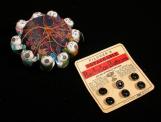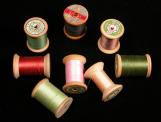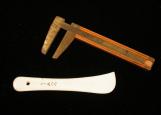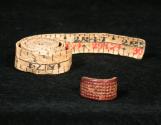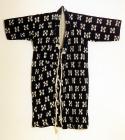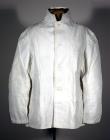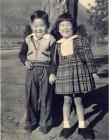1
Sewing at homeSewing at home was an essential way for many Japanese Canadian women to provide clothing for themselves and their families, as well as a means to supplement their income. The culture of sewing at home began young, as Emiko Nakamura's stitching book from the 1930s shows, and was an important aspect of family life.
The women made clothing for work, such as the uniforms Rito Otsuji made for her son, clothing for everyday, like the children's clothing resourcefully made by Sayoko Hattori during internment in Lillooet, B.C. in 1943 and the dresses Kimiko Nasu and Motoko Sakamoto designed and sewed in the 1950s, as well as more glamourous gowns for life's special events, like the graduation dress Ayako Kohara made for her daughter Marge and the wedding dress Yoshiko Nakata sewed for her friend Kimiko Nasu.
Equipment for sewing would include the indispensable treadle sewing machine, spools of thread in a rainbow of colours, fabric of course, a bone 'hera' marker, calipers and tapes for measuring, a pair of scissors, leather or metal ring thimbles, pins, and much used wooden rulers and French curves for pattern design.
7
Motoko Sakamoto's Singer treadle sewing machine, ca. 1920s. JCNM Collection, gift of Minnie Hattori.1920
Vancouver, BC

11
Bachelor Buttons, ca. 1940s, and pin cushion, ca. 1950s or '60s. Mary Ohara Collection, JCNM.1950
Vancouver, BC
